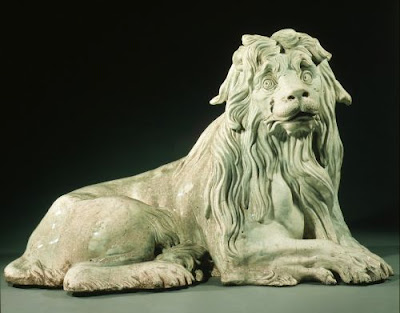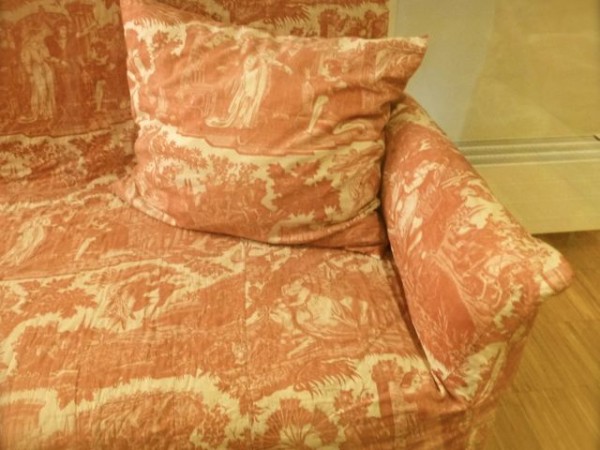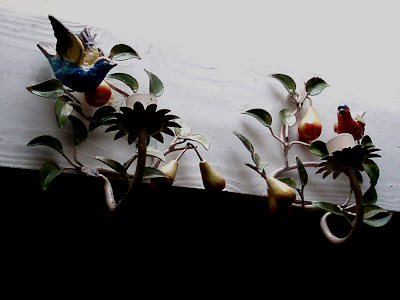Posts from the ‘Isabella La Fitte’ Category
I came across these photos I took last year at the Toile de Jouy Museum. The toiles were all traditional red and white, but I’ve been influenced my Instagram where technology helps reality be more interesting. At the museum there were two slipcover examples–a sofa and a daybed– that are just wonderful. I like them because they look like slipcovers. I have always thought slipcovers should look like slipcovers; they shouldn’t look like upholstery. I mean if you want your sofa upholstered, have it upholstered, right?
Here, the slip cover goes over the cushions–not individually wrapped. I could do without the scallop edge. It seems like a tedious amount of extra work.
The day bed–the curtains are a bit grand, but why not–who wouldn’t want a good pelmet?
 Gertrude Stein during her lecture tour in America, May 2, 1935.
Gertrude Stein during her lecture tour in America, May 2, 1935. Alice B. Toklas and Gertrude Stein on the Terrace at Bilignin, June 13, 1934.
Alice B. Toklas and Gertrude Stein on the Terrace at Bilignin, June 13, 1934.  Gertrude Stein at the Abbey of Hautecombe (Luc du Bourget, Savoie, France), June 12, 1934.
Gertrude Stein at the Abbey of Hautecombe (Luc du Bourget, Savoie, France), June 12, 1934. Gertrude Stein with Pepe; Mark Lutz with Basket I on the Terrace of the Villa at Bilignin, June 13, 1934.
Gertrude Stein with Pepe; Mark Lutz with Basket I on the Terrace of the Villa at Bilignin, June 13, 1934.  Gertrude Stein and Alice B. Toklas at Les Charwelles, June 12, 1934.
Gertrude Stein and Alice B. Toklas at Les Charwelles, June 12, 1934.
Carl Saigon, in his Cosmos series says that human life exists as ten seconds on the time-line of the cosmos; Isabella sent me links to images of Gertrude and Alice on the NYPL Digital Gallery. These are some of my favorites.
“Dearest Pontius,” Isabella told me. “Los Angeles is not that inspiring.”
The narrative is evident. Inspiration left before the momentum built and 1 Car per Green ended almost before it began. I thought I’d give it all up until one day (like any other day) I came across a stack of World of Interiors from the 90’s where I was happily dropped into a Paris Apartment by Jean Dunand. Here it was photographed in it’s pristine original condition untouched–as they say– by time.
The gold leaf still bright, the rabbit fur sofa and bed spread pristine and white. The Living room was my favorite, silver and pale blue and gilt. Chairs exquisite turned into graceful serpentine curves. Sigh. Who says context is not decisive? Living in this kind of apartment, one would become a different person. It would inspire a sartorial lift! One would act on a new stage preparing lines for a new play.
One of my favorite design books is “Decorating is Fun!” In it, Mrs. Draper shares a charming story of the transformation of one of her clients.As I recall it, the client is a young single woman who has newly inherited a frumpy & plain apartment. She herself is frumpy and plain. She is without prospects and in comes to Mrs. Draper for a little help, and how. From the redecoration of the apartment, the young lady goes through her own personal redo. She starts going to the hairdresser. She starts to wear make up. She takes an interest in her clothing. People start to take an interest in her! Before you know it she tosses out her glasses and is engaged to be married.
It’s the intrigue of the environment which I have seen myself. In London I worked for the stylish decorator, Gillian Rogerson. There was a client coined, Miss Grey.
Miss Grey’s whole apartment was grey: the walls; the curtains; the carpet; the furniture. She wore grey clothes. She had grey hair and even grey eyes. At first, she only considered grey, but after about a month inspired by Ms. Rogerson’s own flair one day Miss Grey appeared with alacrity at the door to answer the bell in bright red lipstick a pale blue sweater and pearls, smiling.
Portrait of a Lady; probably Mary Parsons, later Mrs Draper Lely, Peter (painter) c 1665. It’s unfortunate that the Fitzwilliam Museum does not show their paintings on line with frames.


I always remember Bruce Chatwin’s book On The Black Hill. Adult twin brothers live in their family home in the Welsh countryside. They have a fear of antique pickers coming to their door.




















